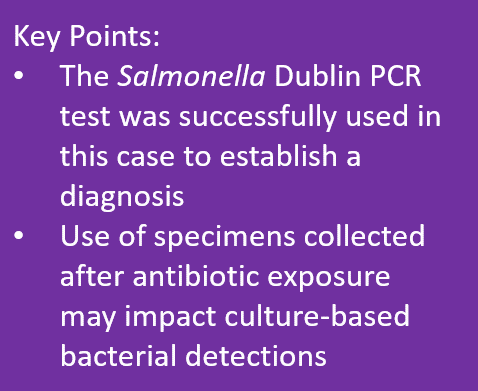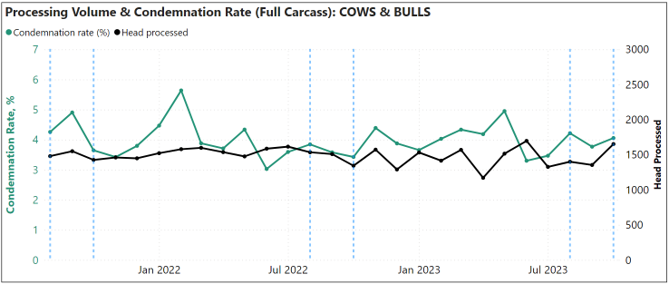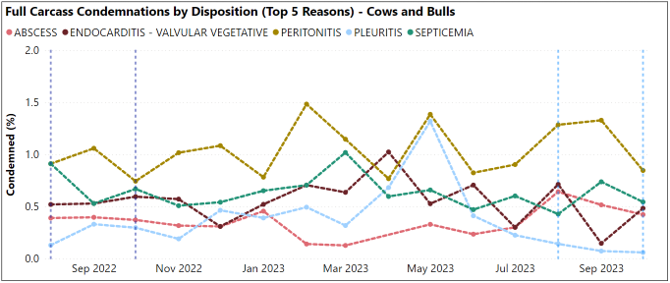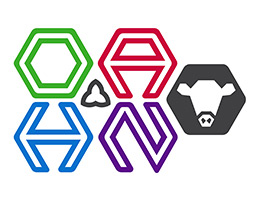Ontario Animal Health Network (OAHN) Bovine Expert Network Quarterly Veterinary Report
OAHN Bovine Producer Survey on Digital Dermatitis
The OAHN bovine network has a producer survey open to better understand the presence of digital dermatitis on Ontario feedlots and actions producers are taking for its control.
Please share with feedlot owners/managers. All responses are anonymous.
Access using the QR code or at: https://uoguelph.eu.qualtrics.com/jfeform/SV_eEe4EF0CxnDitzo/

Q3 Bovine Data from the Animal Health Laboratory
Laboratory Diagnostic Report
A total of 1607 bovine cases were submitted to the AHL during Q3, spanning from August 1 to October 31, 2023. Of these, 159 submissions had a pathology component, consisting of 61 postmortem cases and 98 send-in cases (including 32 meat inspection cases). Of these, there were 29 reproductive loss investigations, 31 young calves (under 2 months of age), 42 older calves (2 months to 2 years of age) and 25 adult cattle. Submissions from practitioners included 78 dairy, 35 beef, and 14 where the commodity was not specified. Insufficient clinical history was associated with 5 submissions.
Pathology Cases of Interest
Case 1: Verminous pneumonia in a beef steer
History: One yearling steer, poor-doer but no recent history of overt disease, sudden death on pasture. Located in Huron County.
Pathology: On-farm necropsy revealed grossly abnormal lungs and many 2.5 cm long lungworms within bronchioles. Microscopic examination identified severe chronic active granulomatous and eosinophilic bronchopneumonia with intralesional nematode ova, and death was attributed to verminous pneumonia.
Ancillary testing: Baermann fecal floatation identified Dictyocaulus viviparous in feces.
Case 2: Yew toxicity in a cow-calf herd
History: Three sudden deaths over a 12-hour period in a herd of 10 Shorthorn cattle. The herd had been in the same field for about a month, and none of the animals had exhibited any signs of illness. One animal was submitted to the AHL for postmortem examination.
Pathology: Necropsy revealed the presence of Japanese yew plant admixed with twigs and roughage in the rumen.
Summary: Exposure to even a small amount of Japanese yew, a common ornamental shrub in North America, is sufficient to cause fatal toxicity due to its cardiotoxic effects resulting in fatal cardiac arrhythmia. In this case, it was confirmed that shrubs had been trimmed on the property and the trimmings were thrown into the pasture with the cattle. This case highlights the importance of careful monitoring of feed/plants/water that livestock have access to, and of considering all potential sources of exposure in cases of suspected toxicity. For more information, here is a link to the AHL newsletter article outlining this case: https://www.uoguelph.ca/ahl/japanese-yew-intoxication-herd-cattle.
Bovine Viral Diarrhea Virus (BVDV) Update
In total, 8 submissions generated 96 samples for BVDV PCR testing, all of which yielded negative results. BVDV immunohistochemistry was not performed for any pathology submissions.
Salmonella Update
In total, 131 bovine submissions had bacterial culture performed (non-milk), generating 275 cultures. Salmonella spp. were isolated from 14 submissions, representing an estimated 11 premises.
- Salmonella Dublin was isolated from 5 submissions, representing approximately 4 premises (one with no previous isolation of this pathogen). All submissions were tissues from dairy and beef calves ranging from 10 days to 3 months of age, with a clinical history of sudden death, diarrhea and pneumonia, or increased calf morbidity/mortality (specific clinical signs not specified).
- Salmonella Uganda was isolated from feces and blood culture from a total of 3 calves with diarrhea (all veal calves from the same operation).
- Salmonella Hartford was isolated from the feces of a 2-year-old animal that presented with lethargy and watery hemorrhagic diarrhea.
- Salmonella Braenderup was isolated from two separate submissions. One was from a fecal swab associated with a clinical history of several cows exhibiting diarrhea, pyrexia and a drop in milk production. The other was from a 5-year-old beef cow that had bronchopneumonia caused by Mannheimia hemolytica, with this Salmonella spp. being concurrently isolated from enrichment.
- Salmonella Anatum was isolated from feces from calves with diarrhea.
| About This Report |
| This summary has been compiled by Dr. Rebecca Egan, Animal Health Laboratory (AHL) from diagnostic submissions to the AHL Guelph and Kemptville locations. |
Practitioner Case Report: Salmonella Dublin Outbreak in a Holstein Dairy Herd
Submitted by: Dr. Mike Krystolovich, Upper Grand Veterinary Services
On October 7, 2023, we were called to a Holstein dairy farm to submit a heifer calf to the Animal Health Lab (AHL) for a postmortem exam. This one-month-old calf was the fifth death after showing signs of respiratory disease during an ongoing investigation for high calf morbidity and mortality during the previous 3 weeks. Clinical signs of this calf and others included fever, depression, inappetence, weakness and increased respiratory rate and effort. Four of the previous calves that died were between 1 and 2 months of age, had high fevers with refractory respiratory signs and severe lung sounds; amongst those, 3 also developed bloody diarrhea.
 Calves on this farm are housed in hutches while on milk replacer and moved to super hutches once weaned. Calves at this time were not being vaccinated. Cows are milked in a tie-stall and calve in the close-up dry cow pen. Cryptosporidium had been previously diagnosed on the farm in August of this year, and calves had been preventatively treated with halofuginone lactate prescribed by the herd veterinarian according to label dose. A small handful of genetically valuable cows had been purchased and entered the herd over the previous year.
Calves on this farm are housed in hutches while on milk replacer and moved to super hutches once weaned. Calves at this time were not being vaccinated. Cows are milked in a tie-stall and calve in the close-up dry cow pen. Cryptosporidium had been previously diagnosed on the farm in August of this year, and calves had been preventatively treated with halofuginone lactate prescribed by the herd veterinarian according to label dose. A small handful of genetically valuable cows had been purchased and entered the herd over the previous year.
The producer had been treating calves experiencing respiratory disease with multiple treatments of florfenicol and a NSAID. Treatment was unrewarding such that they would not improve, but not get worse until after the treatment had worn off. Courses of injectable trimethoprim sulfa (TMS) and NSAIDs were attempted for calves experiencing both pneumonia and diarrhea. Additionally, calves with severe diarrhea and subsequent dehydration were treated with intravenous fluids and oral electrolytes. As a last resort, some of the calves were prescribed label doses of marbofloxacin under the suspicion of Salmonella Dublin and poor response to other therapies.
Out of 15 calves in hutches, 5 died and 10 were sick over a 3-week period. One postmortem was performed on farm before October 7, after one of the calves on intravenous fluids and antimicrobial therapy perished. The exam revealed fluid and fibrin in the abdomen and some small areas of red congested lung. The livers were slightly pale yellow compared to normal and mildly enlarged. At this time, the owner declined sending samples to the lab and was left with an empirical diagnosis of peritonitis and sepsis. Salmonella Dublin was the top differential diagnosis.
The suspicion was confirmed with the calf submitted to AHL on October 7, 2023. Gross findings included peritonitis, necrotizing typhlitis and rupture, and multiorgan congestion and hemorrhage indicating sepsis. Parts of the lungs were dark red, rubbery and wet. Histopathology confirmed signs of bacterial sepsis. No bacteria were found on culture of pooled intestine or pooled liver/kidney/lung/spleen, likely as a result of aggressive antibiotic treatment in this calf before death. A Salmonella Dublin PCR was requested on the lung sample and gave a positive result to confirm the suspected diagnosis on this farm. This was an interesting case for the veterinary community as it showed the value of the PCR Salmonella Dublin test when previous therapies might interfere with success of finding Salmonella spp. on bacterial culture. It also demonstrates how devastating this pathogen can be on a dairy farm. We are currently testing the recent addition cows with the Salmonella Dublin antibody ELISA.
Acknowledgements:
I would like to thank Dr. Amanda Mansz at AHL who was the case coordinator for this submission who was extremely thorough and addressed all of our concerns promptly and efficiently!
Theileria orientalis Ikeda in New York State
Theileria orientalis genotype Ikeda was found on a dairy farm in Genesee County, New York in August 2022. This will be of interest to Ontario veterinarians as Genesee County is located close to Ontario, east of Niagara Falls between Buffalo and Rochester.
Theileria orientalis is a tickborne protozoan and an emerging disease in the United States. It infects red and white blood cells resulting in bovine infectious anemia. Clinical signs from the Ikeda genotype appear similar to anaplasmosis. Cattle may present with anemia, icterus, weakness, or sudden death. Mortality has been estimated at 5% in affected herds. Cattle that recover typically become carriers.
Theileria spp. are typically transmitted by infected ticks or by mechanical transmission such as re-use of needles. In Asia, Australia and New Zealand, the primary tick vector for T. orientalis Ikeda is the Asian longhorned tick (ALH). ALH was first detected in the USA in 2017 and has since been found in 19 States as of October 2023.
For more information on the detection in NY: https://www.vet.cornell.edu/animal-health-diagnostic-center/news/theileria-orientalis-ikeda-new-york
For more information on Theileria orientalis Ikeda: https://www.aphis.usda.gov/animal_health/downloads/theileria-orientalis-ikeda-notice.pdf
For more information on the current status of the Asian longhorned tick in the United States: https://tickapp.tamu.edu/wp-content/uploads/sites/12/2023/10/Asian-Longhorned-Tick-SitRep-2023-10-13.pdf
OMAFRA Bovine Provincial Slaughter Condemnation Data
Q3 2023 (August – October)
Cows and Bulls:

a. Monthly condemnation rate (green, excludes condemnations due to technical issues related to slaughter, transport, handling, or inspection) and number of cows/bulls processed (black) in Provincial abattoirs during the last 2 years. Quarter 3 (August – October) 2021, 2022, and 2023 are highlighted by the dashed blue lines.

b. Condemnation rates (%) for the top 5 cow/bull carcass disposition categories for the past year, with Quarter 3 2022 and 2023 highlighted by the dashed lines. Peritonitis (olive) was consistently the top disposition reason associated with full carcass condemnations this quarter, while condemnations due to pleuritis (light blue) continued to fall throughout the quarter.
Global Surveillance – Bluetongue in the Netherlands
Beginning in September 2023, an outbreak of bluetongue virus was reported on four sheep farms in the Netherlands. This was the first detection of Bluetongue in the Netherlands since 2009. As of January 8, 2024, the country reports 4,421 confirmed PCR positive blood tests in both cattle herds and sheep flocks. Whole genome sequencing has confirmed that the virus is serotype 3 and the variant differs from previous outbreaks worldwide. There is no vaccine available for serotype 3.
Belgium, Germany and the United Kingdom have all since reported cases of serotype 3. Most recent numbers from December 2023 indicate 15 outbreaks in Germany, 4 in Belgium, and 17 farms in Kent and Norfolk in the United Kingdom.
Updates on the Netherlands outbreak can be found at: https://www.nvwa.nl/onderwerpen/blauwtong/documenten/dier/dierziekten/overige-dierziekten/publicaties/index
Extensive drug-resistant Salmonella infections linked to raw pet food and contact with cattle
An update on the Public Health Agency of Canada investigation into an outbreak of extensively drug-resistant Salmonella I 4,[5], 12:i:- illness in individuals from six provinces is available at https://www.canada.ca/en/public-health/services/public-health-notices/2023/outbreak-salmonella-infections-under-investigation.html.
Help us help you!
Have an idea for an infographic you’d like to see, or a podcast you’d like to hear? Email oahn@uoguelph.ca to let us know!


